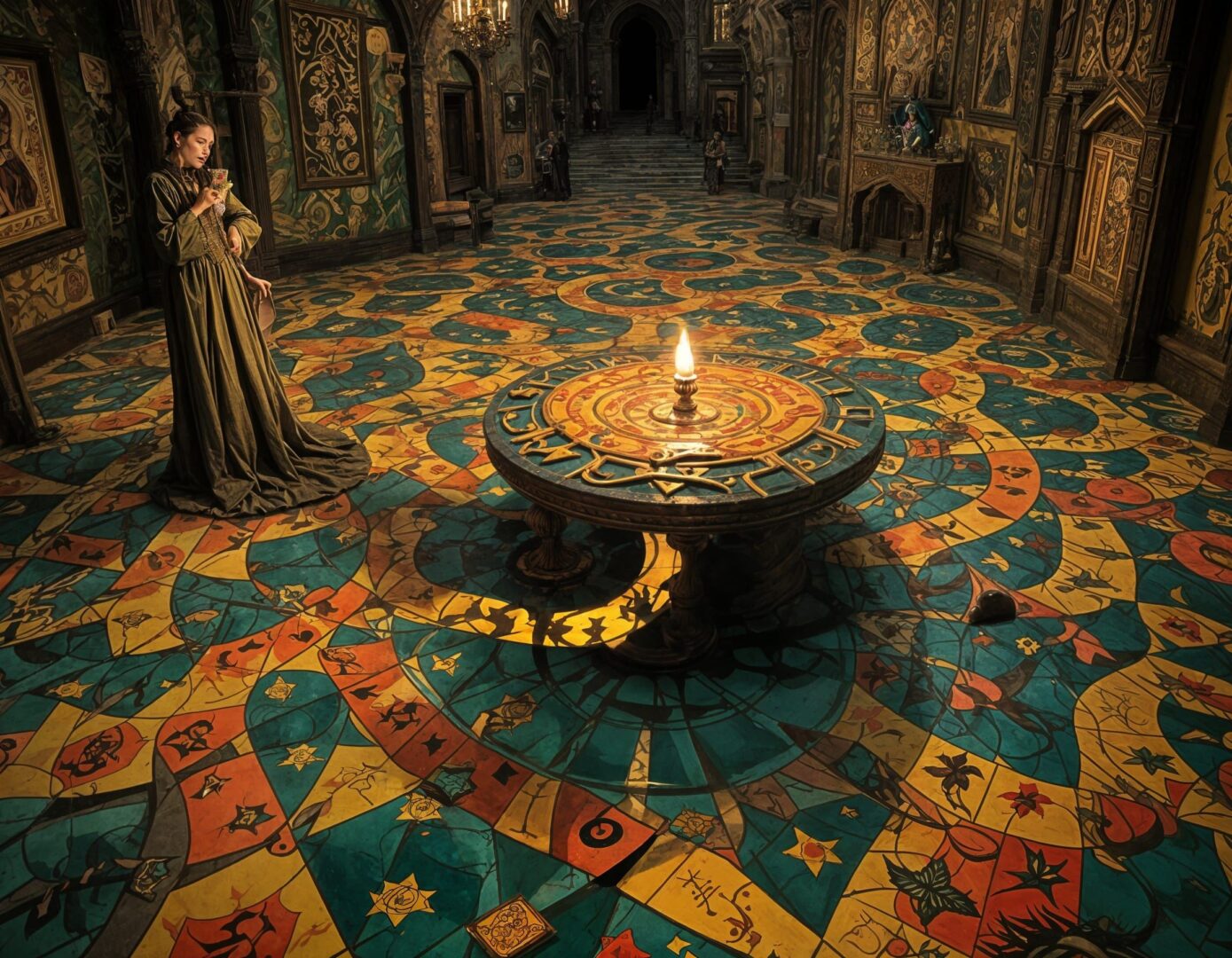
The Jester’s Labyrinth
Complexity: Complex
Type: Magical
Severity: Dangerous
Trigger: Emotional reactions
Effect: Navigate an ever-shifting maze with psychological and physical hazards
Damage Output: 2d10 psychic damage (levels 1-4), 4d10 psychic damage (levels 5-10), 8d10 psychic damage (levels 11-20) (Psychic)
Detection DC: Perception DC 16, Investigation DC 18, Arcana DC 20
Disarm DC: Performance DC 15 (or Calm Emotions + Investigation DC 18)
The Jester’s Labyrinth presents a feast for the senses. The air is thick with playful magic, swirling in ephemeral patterns around the intruders. Painted walls boast vibrant colors—yellows, reds, and greens—where images of laughing jester faces draw the eye and enrapture the mind. The ground is uneven, filled with illusory pitfalls and animated playing cards that spring to life at the careless step, revealing gleaming edges that glint with mischief. As laughter echoes off the walls, it builds in intensity, pulling at the creatures within the maze, urging them to express their emotions—laughter resonating with joy, whispers of fear creeping in their minds. When the trap is triggered, the walls undulate, invoking a strange dance of colors and sounds, leaving adventurers to navigate and endure the playful torment of the jester’s spirit.
Gameplay Notes for The Jester’s Labyrinth Trap
Trap Activation
- Activation Trigger: The Jester’s Labyrinth activates when characters exhibit strong emotional responses such as laughter, fear, or joy. Each time a character fails a saving throw against an emotional challenge (described below), the trap is triggered.
- Environmental Conditions: The trap begins its action as soon as characters step into the maze-like area or approach certain patterns or murals on the walls displaying psychotropic visuals. The disembodied laughter increases in volume and the walls visibly shift, altering the maze layout.
Detection and Disarm Notes
Detection:
- Perception Check (DC 16): Characters may hear the laughter intensifying as they approach certain sections of the labyrinth, which could foretell a trap activation.
- Investigation Check (DC 18): Analyzing the shifting walls can reveal patterns, enabling characters to anticipate changes or discover hidden pathways.
- Arcana Check (DC 20): Characters may sense a magical disturbance related to emotions and realize that emotional responses can affect their surroundings.
Disarm Mechanism:
-
Perform Skill Challenge (DC 15): A character can attempt to amuse the jester’s spirit by making a clever jest or entertaining performance.
- Success: The walls calm for two rounds, allowing characters to navigate freely or locate an exit.
- Failure: The walls react negatively, increasing the intensity of the hazards instead.
-
Spells: Casting Calm Emotions or a similarly suitable spell briefly disrupts the trap’s connection to the jester. A character then may make an Investigate check (DC 18) to identify a weak point in the walls for a potential escape.
Suggested Tactics and Variations
-
Adjusting Challenge Levels:
- For lower-level parties (Levels 1-4), emphasize the disorienting effects of the labyrinth, with fewer aggressive attacks and more harmless but confusing illusions.
- For higher-level parties (Levels 11-20), the psychic damage can appear as vivid, unsettling visions, and walls might actively attack players rather than merely create hazards.
-
Targeting Specific Characters:
- Utilize the emotional challenges based on individual character backgrounds (e.g., one character might be confronted with visions that evoke fear due to previous trauma).
- Probe for vulnerabilities, ensuring that emotional responses come into play, targeting characters least likely to handle psychic damage well.
Initiative and Round Actions
- Trap Initiative: The Jester’s Labyrinth has a Dexterity initiative bonus of +2 and rolls 1d20 + 2 for its initiative order.
-
Actions per Round:
-
Round 1: Initial shift and attack.
- Dexterity Saving Throw (DC 13): Characters who fail are pushed into a hazardous square filled with animated playing cards, dealing 1d6 slashing damage and requiring a DC 11 to avoid the hazard.
-
Subsequent Rounds:
- At each following round (2-4), the walls shift, with a d4 rolled each round:
- On a roll of 1 or 2: Character must make a Wisdom Saving Throw (DC 15) against a wave of illusions that may cause fear.
- Psychic damage occurs based on character level:
- Levels 1-4: 2d10 psychic damage.
- Levels 5-10: 4d10 psychic damage.
- Levels 11-20: 8d10 psychic damage.
- Any character who laughs successfully during emotional challenges stabilizes the walls for that turn.
- At each following round (2-4), the walls shift, with a d4 rolled each round:
-
Round-by-Round Effects Overview
-
Round 1 (Initial Activation):
- Actions: Walls shift; characters must save against DC 13 (Dexterity) or take damage.
-
Round 2:
- Actions: Roll d4: On 1 or 2, characters must make Wisdom save DC 15 or be frightened.
- Damage: Based on character level (psychic).
-
Round 3:
- Actions: Repeat d4 roll to incorporate new emotional challenges and damage.
- Note any character hit by reduced walls or any individual performance challenges.
-
Round 4:
- Actions: Walls become more unstable.
- If disarmed or calmed, roll to assess impact of emotional challenges or create paths of relief.
-
On-Going (After Initial Four Rounds):
- Continues to present threats and psychological challenges unless characters engage with the environment effectively, successfully disarming, or appeasing the spirit.
Additional Tips for Smooth Running:
- Engagement with Emotions: Encourage players to role-play their characters’ emotional reactions to enhance the chaos and immersion of the labyrinth.
- Track Damage and Conditions: Keep a visual tracker for each character’s status (health, fear condition) to manage escalating threats easily.
- Consult Character Backstories: Utilize knowledge of characters’ backgrounds to craft tailored emotional stimuli, making the experience richer and more personalized.
- Visual Aid: Consider using diagrams or visual mapping tools for the labyrinth to convey the shifting nature of the environment effectively.











